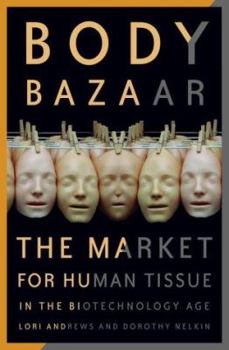Body Bazaar: The Market for Human Tissue in the Biotechnology Age
Select Format
Select Condition 
Book Overview
Provides a look at the growing trade in human DNA, tissue, blood, bones, embryos, and other commodities and assesses the implications of such access to biological material and genetic information in... This description may be from another edition of this product.
Format:Hardcover
Language:English
ISBN:0609605402
ISBN13:9780609605400
Release Date:February 2001
Publisher:Crown Publishing Group (NY)
Length:256 Pages
Weight:0.90 lbs.
Dimensions:0.9" x 5.8" x 8.6"
Customer Reviews
2 ratings
Easy Read for the Non-scientist
Published by Thriftbooks.com User , 23 years ago
Andrews and Nelkin have done a good job of describing the burgeoning field of biotechnology in layman's terms. Although redundant at times, the authors get right down to the nitty-gritty on issues of tissue marketing, genetic manipulation, assisted reproduction, embryonic research, cloning and other current topics. The book also explores the ethical issues of these rapidly expanding fields, which is particularly relevant in view of the money to be made on lucrative discoveries by researchers and companies who place the bottom line above human rights. This book is recommended for anyone who wants to know about DNA but is afraid to ask.
Who Owns Your Body?
Published by Thriftbooks.com User , 23 years ago
If you took a human being and dismantled the body into its elements of carbon, hydrogen, oxygen, phosphorus, and the rest, you would get a collection of pure chemicals that used to estimated as worth 89 cents. That's what you get if you take all the information and structure away. Information and structure within our bodies are worth something, and are worth more and more every day as we are able to understand them better. And here's a disturbing thought: someone else may own those particular details on your own particular body. And sell them.According to Lori Andrews and Dorothy Nelkin, in their troubling book _Body Bazaar: The Market for Human Tissue in the Biotechnology Age_ (Crown Publications), that's happening often. It happened to John Moore, who about fifteen years ago was being treated by a specialist for hairy-cell leukemia. As you can imagine, such treatment required a lot of tests on Mr. Moore's body, but it seemed to Moore that there were too many going on, and that the doctor was secretive, and insistent that the blood, and then bone marrow and skin and semen, had to be obtained at his own lab. Moore investigated, and found that he had become patent number 4,438,032. The doctor had found that there were certain unique chemicals in Moore's blood, and the pharmaceutical company Sandoz had reportedly paid $15 million for the right to develop a cell line taken from Moore. The doctor seems to have said that he had found a "gold mine" in Moore, and Moore indeed felt he had been "harvested." So, of course, Moore sued for property theft. In 1990, the California Supreme Court ruled in favor of the doctor, saying in effect that Moore didn't own his body parts, but the ones who discovered and patented them did. Author Andrews is a legal scholar and bioethicist at the Illinois Institute of Technology, and Nelkin is a New York University professor of law. They offer many other troubling examples of what we would intuitively regard as people's rights to their own body chemistry being smashed for the profits of gene-hunters and corporations. Issues of genes are not the only problems covered in this worrisome book, which is an excellent introduction into a world we are just now making for ourselves. It also considers such things as the ownership of bodies which are prepared for artistic display; the Korean Ear Mound in Kyoto, Japan, a collection of body trophies from the Japanese-Korean War four hundred years ago; and the web sales of a firm called Skulls Unlimited. The genetic issues, because of their novelty, are certainly the most enigmatic, and the authors quite rightly raise questions about non-medical issues such as DNA typing of criminals, military people, or minorities to go into a computer whose usage may be unlimited. It is perhaps regrettable that the final chapter of the book, where one would expect intelligent recommendations for solutions, is only seven pages long, and contains more questions than answers. That is,





